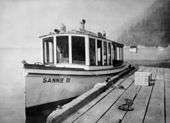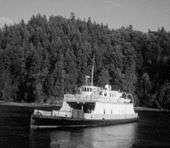Bowen Island Ferry
The Bowen Island Ferry travels between Snug Cove, at Bowen Island, and Horseshoe Bay, in the District of West Vancouver, British Columbia, Canada, a trip of three nautical miles across Howe Sound. A scheduled ferry has been in operation since 1921, when Bowen Island was a popular holiday destination. Prior to that year, transportation to the island was by steamship from Vancouver, with only one trip daily.[1] The Bowen Island ferry used a fleet of small passenger vessels until 1956, when a single car ferry began passenger service, and that ferry began carrying vehicles in 1958. In 2012 the ferry carried in excess of 870,000 passengers plus 360,000 vehicles.[2]



Sannie Transportation Company
Initially a passenger-only route, the Bowen Island ferry was begun in 1921 by John Hilton Brown, a British shipmaster, under the name Sannie Transportation Company. He began the enterprise using his wife's yacht Sannie, named after a winning Australian race horse, plus two newly built craft, Sannie II and Sannie lll.
The company grew under the leadership of Thomas David (Tommy) White, who joined in 1921 and soon became president. He enlarged the fleet, adding the Sannie IV, Sannie V, Samina, and Thunderbird II. He expanded the market, developing a regular schedule to Hood Point, at the north end of Bowen Island. White married another ferry operator, Mary Marshall, in 1949, and they worked on the ferries until 1954.[3]
Union Steamship Company
In 1938 demand for Bowen Island ferry service increased with opening of the Lions Gate Bridge between Vancouver and West Vancouver. During 1939-1941 the Union Steamship Company operated two ferries between Bowen Island and Whyte Bay (which is near Horseshoe Bay), in competition with Sannie. In 1945 Union purchased the Sannie Transportation Company and retained Tommy White as ferry manager.
Beginning in 1946 the Union Company operated eight fast ferries which used Whyte Bay as a terminus during summer months and used Horseshoe Bay in the winter. This Union subsidiary was named Howe Sound Ferries Limited, although the boats were registered to the Sannie Transportation Company. These were the Commuter, Chilco, Bowen, Chasina, Island Flyer, Island Spray, Cheam, and Cheakamus. But fuel costs were high and most vessels were sold by 1950, although Whytecliff service was maintained until 1952. The remaining Sannie Horesehoe Bay ferries had difficulty meeting demand, and Bowen Island residents petitioned for better service.
In 1956 the original 1921 fare of twenty-five cents was raised to seventy-five cents and ferry patrons, long dissatisfied, became outraged with the combination of higher fares and an inadequate schedule. The provincial government pressured the ferry company to relinquish its licence and allow the Black Ball Line, which owned a larger ferry, to take over the route.[3]
Black Ball Line
Black Ball Line passenger service between Bowen Island and Horseshoe Bay began in December 1956 with the MV Bainbridge which began carrying vehicles upon completion of a new berth at Snug Cove in 1958. The Black ball Line had been operating in British Columbia since 1951, when some vessels were moved north from Puget Sound after the other assets were purchased by the State of Washington. The government of British Columbia acquired the BC Black Ball ships and terminals 1961 for $6.6 million.[4][5]
B.C.Ferries
Black Ball was absorbed by the BC Highways and Bridges Toll Authority Ferries, later to become British Columbia Ferry Corporation which has served Bowen Island since that time. The ferry corporation was a crown corporation, that is, state-owned, and it retained that status until 2003[6] at which time it was reorganized into a private corporation, solely owned by the provincial government's BC Ferry Authority. Early BC Ferries ships on the Bowen Island route included, in 1962, the wooden-hulled Cy Peck and the original Bowen Queen (imported from Kelowna and later renamed Vesuvius Queen).[7] A second Bowen Queen was launched in 1965, and the Howe Sound Queen was imported from eastern Canada in 1971.[8][9]
Water Taxis
The Bowen Island ferry has been supplemented over many decades by a dozen or more Howe Sound water taxi companies providing on-demand trips and occasional scheduled shuttles. These have included PDQ Water Taxi (Ian Arthur), Mercury Water Taxi (Frank Wright), Radio Water Taxi (Bill Dunbar, Don Nemrava), Horseshoe Bay Water Taxi (Bill Jewett), Freemac Amphibious Taxis (Jack and Connie McPhillips, and Harold and Dorothy Freeston), Pete's Water Taxi (Pete Labrie), and Cormorant Marine Services (Brian Biddlecombe).[10] [11][12]
References
- Howard, Irene (1973). Bowen Island 1872-1972. Bowen Island Historians, 190 pp.
- BC Ferries (2012). Traffic Statistics System. Total Vehicle and Passenger Counts by Route for December 2012. 4pp.
- Ommundsen, Peter D. (1997). Bowen Island Passenger Ferries. The Sannie Transportation Company 1921-1956. Cape West Publishing, 64 pp.
- Lauder, Patricia (2002). Guide to Ferryboats of Puget Sound. Pro Star Publications, 145 pp.
- Cadieux, H.L. and Garth Griffiths (1967). Dogwood Fleet. Cadieux and Griffiths Ltd., 118 pp.
- Annual Report, BC Ferries, 2003-2004.
- Clapp, Frank A. (1988). "Pioneer Ferry of the Gulf Islands." Steamboat Bill. Journal of the Steamship Historical Society of America, 187:191-196.
- Favelle, Peter (1974). The Queens of British Columbia. A Detailed Account of the Ships in the BC Ferry Fleet. Discovery magazine, Limited, 100 pp.
- Bannerman, Gary, and Patricia Bannerman (1985). The Ships of British Columbia. An Illustrated History of the British Columbia Ferry Corporation. Hancock House, 176 pages.
- Fox, Margaret and Angela Keown. (1971). Cha-Hai (Horseshoe Bay) A Look at the Past! Gleneagles Parent Teacher Association, 49 Pages.
- Hanen, Edythe (1998). "Cormorant Carries on Island Traditions." The Bowen Island Undercurrent, 26(8):5, February 20.
- Sun Directories Limited. (1949). Greater Vancouver and New Westminster City Directory.
Further reading
- Bannerman, Gary, and Patricia Bannerman (1985). The Ships of British Columbia. An Illustrated History of the British Columbia Ferry Corporation. Hancock House, 176 pages.
- Cadieux, H.L. and Garth Griffiths (1967). Dogwood Fleet. Cadieux and Griffiths Ltd., 118 pp.
- Favelle, Peter (1974). The Queens of British Columbia. A Detailed Account of the Ships in the BC Ferry Fleet. Discovery Magazine, Limited, 100 pp.
- Heal, S.C. (2010). Ferries West. A West Coast Photo Album. Cordillera Books,226 pp.
- Ommundsen, Peter D. (1997). Bowen Island Passenger Ferries. The Sannie Transportation Company 1921-1956. Cape West Publishing, 64 pp.
- West Coast Ferries Forum